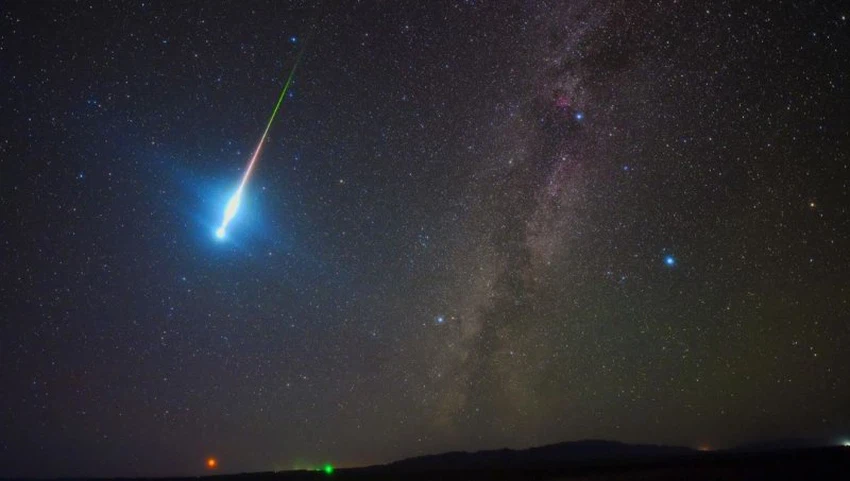Jordanian Astronomical Society: The skies of Jordan and the Arab region witness the phenomenon of Perseid meteors on August 12
Weather of Arabia - Dr. said. Ammar Al-Sakji, President of the Jordanian Astronomical Society, the peak of the annual Perseids meteor shower occurs on the night of Monday/Tuesday, August 12 to August 13, and these meteors are the result of the remains of the comet Soft-Teotul, which orbits the sun once every 135 years and occurs when the Earth’s orbit intersects with the remnants and remains of the comet. .
You may also be interested in:
Jordanian Astronomical Society: New digital standards for planet identification
The reason why the Perseid meteors were given this name
The Perseid meteors were given this name in relation to the constellation Perseus because the center of the meteor radiation appears as if it came out of this constellation, and they are made of different sizes of sand grains (the size of a lentil), but if they are a little larger like a bean, an extended fireball occurs with bright and picturesque colors, and extends to... For several seconds, these granules enter the atmosphere at a speed of more than 60 kilometers per second (216 thousand kilometers per hour), and interact with the components and molecules of the atmosphere. The temperature of the granules rises to 1650 degrees Celsius, ionizes the air, and burns at varying altitudes from 70 to 100 km to produce a meteor. The Perseid meteor shower is one of the brightest and most exciting meteor showers in the sky. These showers will continue from July 17 to August 24, 2024. These meteor showers are considered safe and not dangerous because most of the sand grains burn in space and turn into ash.
The peak rate of the Perseid meteors per hour (ZHR), which is the number of meteors expected to be seen by one observer per hour at the peak of activity if the center of radiation is at the highest elevation in the sky (zenith), is equal to about 100 meteors per hour according to standard conditions.
According to Jordan's coordinates and its geographical location in relation to the apparent movement of the radiation center, which peaks at five o'clock in the afternoon on Monday, Jordan time. As for Jordan, the radiation center is below the horizon at this time, as the radiation center rises at about 8:12 p.m. on Monday evening, and it remains at its height and increases. The probability of seeing meteors over time, and the recommended times for viewing meteors are from 9:30 Monday evening to 4:30 Tuesday morning, and the best time is after moonset at 11:28 Monday evening.

The best time to watch the Perseid meteors
The best time to watch the Perseid meteors on the night of August 12/13, 2024 is when the center of radiation rises to about 60 degrees, that is, at half past four in the morning on Tuesday, August 13, as the peak rate of meteors at this time is expected to be about 80 meteors per hour, but according to... Geographical location and astronomical conditions: We are expected to see “58 meteors per hour,” and this number may vary depending on weather conditions, including clouds, clear air, dust, etc.
The Perseid meteor shower is a global event in many countries of the world and is considered one of the astronomical events of interest to astronomers, photography enthusiasts, and sky lovers.
According to the annual report of the International Meteor Organization 2024 (IMO), Jordan is located among the preferred regions globally for observing Perseid meteor showers, as well as the countries located in the northern-mid latitudes, in addition to other astronomical standards such as clear air and lack of clouds in this period of the year, where you can see... These meteors come from most areas of Jordan, especially deserts, rural areas, and areas far from light pollution, such as major cities.
Meteor showers and fireballs are visible with the naked eye from the Jordanian sky, on the northwestern side of the horizon, and we advise looking at the sky and in all directions. One of the methods used to view the Perseid meteors and fireballs is to lie on the ground over a light blanket and look at the sky with the naked eye, if observed. Meteors in general require a little patience in observing the dome of the sky, and people vary in the number of meteors seen according to different observing skills. We would like to point out that we are facing a “meteor shower” and not a “meteor storm” because the latter has a much greater number of meteors than that.
In November 1999, the International Meteor Organization announced that Jordan was “the best in the world” in monitoring similar meteors called the “Leonid Meteor” storm. The Jordanian Astronomical Society, in cooperation with the International Meteor Organization, organized a camp and a global conference attended by many astronomers and specialists from countries around the world and published scientific research. A court on the phenomenon of Leonid meteors, their number and monitoring, and comparing astronomical observation with theoretical astronomical studies, as there was a correspondence between theoretical studies and the number of meteors observed in the Jordanian Astronomical Society camp in Azraq.
See also:
Jordanian Astronomical Society: Discovery of a cave on the moon
Arabia Weather App
Download the app to receive weather notifications and more..



